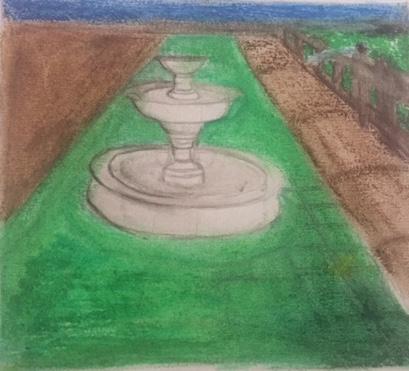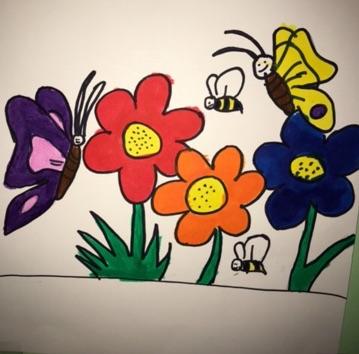Claude Monet loved art and nature. He combined those two loves by planting colorful gardens wherever he lived and then painting them. Monet carefully planned his gardens to be beautiful and different in every season, and he painted many different versions of his gardens.

Language
Look
What is one word you would use to describe this painting?
What season of the year might it be? What do you see that makes you say that?
Follow the path through the painting with your eyes. What is in the front or foreground, closest to you? The middle ground? The background?
Imagine you are inside this scene. What would it feel like to be there? What would you do first?
Read
The Gardener’s Surprise (Spanish language version: La sorpresa del jardinero)
by Carla Balzaretti and Sonja Wimmer
Andrew loves flowers and is thrilled when he has the opportunity to tend a large garden and to pursue his passion.
The Green Fingers of Monsieur Monet
by Giancarlo Ascari and Pia Valentinis
This books tells the story of Monet and his garden, which he later painted in many artworks.
Make: Draw a Garden
You Will Need
- Pencil
- Oil pastels
- White paper
Like Claude Monet, you will need to plan your garden before you can draw it! You will also need to decide what time of day and season of the year it will be in your garden scene. What colors would you use to show a morning sky, or the garden in autumn? Will you make a path through your garden? Where might it lead?
Next, use oil pastels to fill your garden with color. Working with one color at a time, add flowers to the garden. Then fill in around the flowers with stems and leaves. Try layering and blending your colors to see what happens!
Vocab Bank
- inspiration
- pastel
- scene
Download
Art Tales: Coloring and Cut-Outs booklet (PDF, 3.5 MB)
Art Tales for Pre-K (PDF, 7.2 MB)
Primeros Pasos En El Arte (PDF, 7.5 MB)
Primeros Pasos En El Arte: Colorear y Recortes (PDF, 3.7 MB)
Monet's Waterscapes lesson plan
An Eye for Art: Claude Monet teaching resource (PDF, 9.4 MB)
Visit
Register for the Art Tales pre-K school tour
Submit Student Work
Send images of your students' projects that follow these activities - email [email protected]
You may also like

Educational Resource: Art Tales: Alma Thomas
A lesson for preschool to kindergarten students about artist Alma Thomas’ painting Pansies in Washington. Students learn how to look at this painting, what you can read to learn more, how to create a color square, and a list of vocabulary terms related to this activity.

Educational Resource: Art Starters: Diego Rivera
A lesson for preschool to kindergarten students about artist Diego Rivera’s painting No. 9, Nature Morte Espagnole. Students learn how to look at this painting, what you can read to learn more, how to make a still life collage, and a list of vocabulary terms related to this activity.

Educational Resource: Art Starters: Georgia O'Keeffe
A lesson for preschool to kindergarten students about artist Georgia O'Keeffe’s painting Jack-in-the-Pulpit No. 3. Students learn how to look at this painting, what you can read to learn more, how to draw a flower close up, and a list of vocabulary terms related to this activity.




